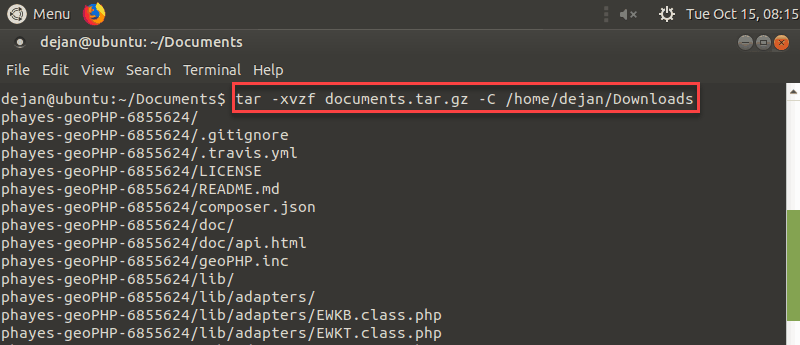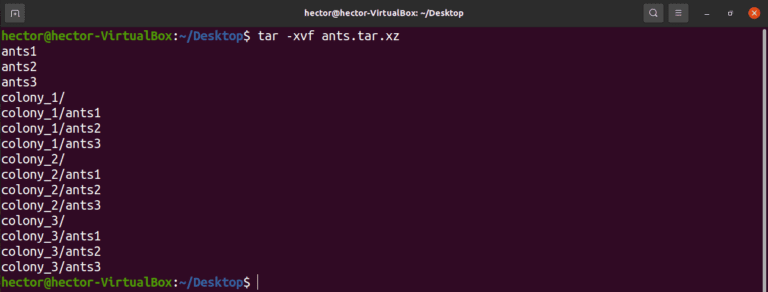
- UNTAR COMMAND IN LINUX FOR TAR GZ HOW TO
- UNTAR COMMAND IN LINUX FOR TAR GZ ARCHIVE
- UNTAR COMMAND IN LINUX FOR TAR GZ ANDROID
Tar can add both files and directories.īelow is an example where we are adding example.jpg into the existing sampleArchive.tar. To do this, we would use the -r option, which stands for append. While you can extract specific files, you can also add files to an existing archive.
UNTAR COMMAND IN LINUX FOR TAR GZ HOW TO
tar.bz2 you can use: tar -jxvf 2 -wildcards '*.jpg' How to Add Files to a. tar.gz you can use: tar -zxvf -wildcards '*.jpg'įor. A sample of such command is shown below: tar -xvf sampleArchive.tar -wildcards '*.jpg'įor. If you want to extract specific patterns of files like only. tar.bz2 you can use: tar -jxvf 2 "file1" "file2" Extract multiple files with a pattern tar.gz you can use: tar -zxvf "file1" "file2"įor. In case you want to extract multiple files, use the below format of the command: tar -xvf sampleArchive.tar "file1" "file2"įor. Or alternatively, one like this: tar -extract -file= 2 example.shĪs you can see, the tar command has a lot of flexibility in its syntax. tar.bz2, you can use a command like this: tar -jxvf 2 example.sh Or alternatively: tar -extract -file= example.sh tar.gz you can use a command similar to the one shown below: tar -zxvf example.sh Alternatively, you can also use the following command: tar -extract -file= sampleArchive.tar example.sh Here example.sh is a single file which will be extracted from sampleArchive.tar. One such example is shown below: tar -xvf sampleArchive.tar example.sh
UNTAR COMMAND IN LINUX FOR TAR GZ ARCHIVE
Once an archive is created, you can extract a single file. tar.bz2 files, as shown below: tar -tvf 2 How to Unzip a Single. tar.gz, you can use a command like: tar -tvf This will display the complete list of files along with timestamps and permissions. Once the archive is built, you can list the contents by using a command similar to the one below: tar -tvf sampleArchive.tar It would require the following command in the command line: tar -xvf 2 How to List the Contents of an Archive in Linux tar.tb2 files can be uncompressed similarly. tar.gz files as shown below: tar -xvf tar -xvf -C /home/ExtractedFiles/ One example is shown below: tar -xvf sampleArchive.tar -C /home/ExtractedFiles/Ī similar command can be used to uncompress. If you want to extract to a different directory, then you can use the -C option. The below command will extract files in the current directory: tar -xvf sampleArchive.tar The tar command can also be used to extract a file. An example of this is shown below: tar -cvjf /home/sampleArchive tar -cvjf 2 /home/sampleArchive How to Unzip. An example of the operation is: tar -cvjf 2 /home/sampleArchive To create this, you need to use the -j option. However, this would take more time to compress and decompress. bz2 file provides more compression compared to gzip.

An example of this is shown below: tar -cvzf sampleArchive.tgz /home/sampleArchive Creating a. The additional option z represents gzip compression. An example of this is: tar -cvzf /home/sampleArchive If you want better compression, then you can also use.


An example of such an archive is: tar -cvf sampleArchive.tar /home/sampleArchive tar compressions for a file as well as directories. Before we start, you’ll need to SSH into your VPS. Let’s learn what basic operations you can perform by using tar. To reduce the usage of space on your system, since compression will occupy less space.Take a backup of your website, data or anything else.To transfer a huge collection of files and folders from one server to another.If you are working on Linux based systems and require file compression.While this helps us understand tar’s benefits, one question to answer is under what scenario would you choose to use it?
UNTAR COMMAND IN LINUX FOR TAR GZ ANDROID
This is available on Android firmware as well as supported older Linux flavors. Tar is widely available across most common Linux versions.The permissions and other features remain intact while compressing Tar does not alter the features of files and directories.Drastically reduces the size of packaged files and folders.Tar, when it comes to compression, has a compression ratio of 50%, which means it compresses efficiently.Tar comes with multiple options though there are a few which you may need to remember. With tar, you can compress and decompress files. Further compression is done using gzip, which would result in a. In most cases, once the compression is done using tar, it results in a. How to List the Contents of an Archive in Linux.


 0 kommentar(er)
0 kommentar(er)
